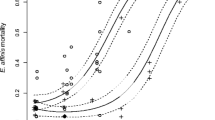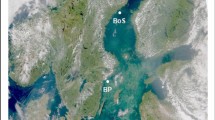Abstract
The ice gouged, shallow, polar seabed is a challenging place to live, but suspension feeders are particularly rich and abundant there. The extreme seasonality of food supply from phytoplankton at high latitudes, combined with very stable temperatures has not, however, reduced the range of life history adaptations. Some species extend feeding and growing periods by concentrating on smaller, lower biomass but longer duration, fractions of phytoplankton. Here we show that shallow-water Antarctic brachiopods can switch from pelagic to benthic food sources when required. Like most suspension feeders they utilise the extremely abundant summer phytoplankton blooms, but unlike many other groups brachiopods do not appear to become dormant in winter. In shallow sites around the world wind and wave action resuspend benthic material, making it available to filter feeders. Widespread ice disturbance at polar latitudes may also cause resuspension enhancing local food supply. Articulate brachiopods have blind-ended guts and probably feed little once a large bolus of food has been collected, so a resuspension event may represent a significant enhancement of yearly food availability. The key to their ability to utilise unpredictable food sources is the same trait responsible for their polar success; very low maintenance costs and a catholic diet. Utilising resuspended material could be an important factor in global brachiopod distributions. Previously difficult to explain high brachiopod densities in New Zealand, Northwest Europe and the Canadian Pacific Coast may occur because these areas are all in the world’s windiest, and hence strongest resuspension, latitudes.










Similar content being viewed by others
References
Arntz WE, Brey T, Gallardo VA (1994) Antarctic zoobenthos. Oceanogr Mar Biol Annu Rev 32:251–303
Barnes DKA (1995) Seasonal and annual growth in erect species of Antarctic bryozoans. J Exp Mar Biol Ecol 188:181–198
Barnes DKA (2002) Polarization of competition increases with latitude. Proc R Soc Lond B 269:2061–2069
Barnes DKA, Clarke A (1995a) Seasonality of feeding ecology in polar suspension feeders. Pol Biol 15:335–340
Barnes DKA, Clarke A (1995b) Epibiotic communities on sublittoral macroinvertebrates at Signy Island, Antarctica. J Mar Biol Assoc UK. 75:689–704
Berner RA, (1994) GEOCARB II: a revised model of atmospheric CO2 over phanerozoic time. Amer J Sci 294:56–91
Brey T, Klages M, Dahm C, Gorny M, Gutt J, Hain S, Stiller S, Arntz WE, Wägele J–W, Zimmerman A (1994) Antarctic benthic diversity. Nature 368:297
Brey T, Peck LS, Gutt J, Hain S, Arntz W. (1995) Population dynamics of Magellania fragilis, a brachiopod dominating a mixed-bottom macrobenthic assemblage on the Antarctic shelf. J Mar Biol Assoc UK 75:857–870
Brockington S (2001) Ecology and physiology of S. neumayeri at Adelaide Island, Antarctica. PhD thesis, The Open University and British Antarctic Survey
Brockington S, Peck LS (2001) Seasonality of respiration and ammonia excretion in the Antarctic echinoid Sterechinus neumayeri. Mar Ecol Prog Ser 259:159–168
Brockington S, Clarke A, Chapman ALG (2001) Seasonality of feeding and nutritional status during the austral winter in the Antarctic sea urchin Sterechinus neumayeri. Mar Biol 139:127–138
Carey AG, Ruff RE (1977) Ecological studies of the benthos in the Western Beaufort Sea with special reference to molluscs. In: Dunbar MJ (ed) Polar oceans. Arctic Institute of North America, Calgary, pp. 505–530
Clarke A, Leakey RJ (1996) The seasonal cycle of phytoplankton, macronutrients and the microbial community in a nearshore Antarctic marine ecosystem. Limnol Oceanogr 41:1281–1294
Clarke A, Holmes LJ, White MG (1988) The annual cycle of temperature, Chlorophyll and major nutrients at Signy Island, South Orkney Islands, 1969–1982. Bull Br Antarct Surv 80:65–86
Doherty PJ (1976) Aspects of the feeding ecology of the subtidal brachiopod Terebratella inconspicua (Sowerby, 1846). MSc thesis, Dept of Zoology, Univ. Aukland, New Zealand
Emson RH (1996) Bone idle, a recipe for success. In: Keegan BF, O’Connor BDS (eds) Echinodermata. Balkema, Rotterdam, pp 25–30
Gilbert NS (1991) Microphytobenthic seasonality in near-shore marine sediments at Signy Island, South Orkney Islands, Antarctica. Estuar Coast Shelf Sci 33:89–104
James MA, Ansell AD, Collins MJ, Curry GB, Peck LS, Rhodes MC (1992) Recent advances in the study of living brachiopods. Adv Mar Biol 28:175–387
LaBarbera M (1984) Feeding currents and particle capture mechanisms in suspension feeding animals. Am Zool 24:71–84
McCammon HM (1969). The food of articulate brachiopods. J Paleontol 43:976–985
Meidlinger K, Tyler PA, Peck LS (1998) Reproductive patterns in the Antarctic brachiopod Liothyrella uva. Mar Biol 132:153–162
Peck LS (1993) The tissues of articulate brachiopods and their value to predators. Phil Trans R Soc Lond B 339:17–32
Peck LS (1996) Feeding and metabolism in the Antarctic brachiopod Liothyrella uva: a low energy lifestyle species with restricted metabolic scope. Proc R Soc Lond B 263:223–228
Peck LS (1998) Feeding, metabolism and metabolic scope in Antarctic ectotherms. Society for Experimental Biology Seminar Series 66, pp 365–389
Peck LS (2001) Ecology of articulates. In: Carlson S, Sandy M (eds) Short course on brachiopods. Geological Society of the USA and University of Kansas, pp171–184
Peck LS, Brey T (1996) Radiocarbon bomb signals verify biennial growth bands in the shells of 50 year old brachiopods from Antarctica. Nature 380:206–207
Peck LS, Bullough LW (1993) Growth and population structure in the infaunal bivalve Yoldia eightsi in relation to iceberg activity at Signy Island, Antarctica. Mar Biol 117:235–241
Peck LS, Clarke A, Holmes L (1987a) Summer metabolism and seasonal biochemical changes in the brachiopod Liothyrella uva (Jackson, 1912). J Exp Mar Biol Ecol 114:85–97
Peck LS, Clarke A, Holmes LJ (1987b) Size, shape and the distribution of organic matter in the Antarctic brachiopod Liothyrella uva. Lethaia 20:33–40
Peck LS, Ansell AD, Curry GB, Rhodes M (1997a) Physiology and metabolism. Chapter III, Treatise on invertebrate palaeontology. Part H, Brachiopoda. U.S. Geological Society and the University of Kansas, pp 213–242
Peck LS, Brockington S, Brey T (1997b) Growth and metabolism in the Antarctic brachiopod Liothyrella uva. Phil Trans R Soc Lond 352:851–858
Reimnitz E, Barnes PW (1975) Sea ice as a geological agent in the Beaufort Sea shelf of Alaska. In: Reed JC, Sater JE (eds) Proceedings of the Symposium on Beaufort Sea Coast and Shelf Research. Arctic Institute of North America, Calgary, pp 301–354.
Rhodes MC, Thayer CW (1991) Effects of turbidity on suspension feeding: are brachiopods better than bivalves? In: MacKinnon DI, Lee DE, Campbell JD (eds) Brachiopods through time. Proc 2nd International Brachiopod Congress, University of Otago, Dunedin, New Zealand, 1990. Balkema, Rotterdam, pp 191–196
Richardson JE (1997) Ecology of articulated brachiopods. In: Kaesler RL (ed) Treatise on invertebrate paleontology. Part H, Brachiopoda, vol. 1. Geological Society of America and the University of Kansas Press, Boulder, Colorado and Lawrence, Kansas, pp 441–462
Rogers AD (2000) The role of oceanic minima in generating biodiversity in the deep sea. Deep-Sea Res II 47:119–148
Round FE, Crawford RM, Mann DG (1990) The diatoms. Cambridge University Press, Cambridge
Sanderson WG, Harding SP, Thorpe JP (1995) An investigation of the effects of tidal fluctuations on the availability of seston as food for intertidal Bryozoa. In: Gordon DP, Smith AM, Grant-Mackie JA (eds) Bryozoans in space and time. National Institute of water and Atmospheric Research, Wellington, pp 259–270
Suchanek TH, Levinton J (1974) Articulate brachiopod food. J Paleontol 48:1–5
Zezina ON (2001) Global surface-water circulation and the main features of brachiopod biogeography. In: Brunton CHC, Cocks LR, Long SL (eds) Brachiopods past and present. Proceedings of the 4th International Congress on Brachiopods, London, July 1999, pp 102–107
Acknowledgements
We thank Ken Robinson for help with electron microscopy, Karen Webb for assistance with Fig. 9, and Clare Allen and Dominic Hodgson for diatom identification. Professor P. Tyler and Dr. E. Harper made very useful comments during the refereeing process that significantly improved the paper.
Author information
Authors and Affiliations
Corresponding author
Additional information
Communicated by J.P. Thorpe, Port Erin
Rights and permissions
About this article
Cite this article
Peck, L.S., Barnes, D.K.A. & Willmott, J. Responses to extreme seasonality in food supply: diet plasticity in Antarctic brachiopods. Marine Biology 147, 453–463 (2005). https://doi.org/10.1007/s00227-005-1591-z
Received:
Accepted:
Published:
Issue Date:
DOI: https://doi.org/10.1007/s00227-005-1591-z




